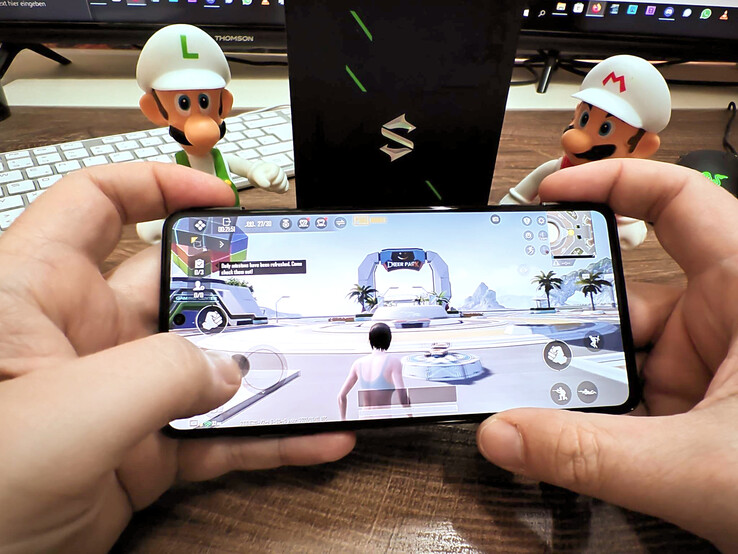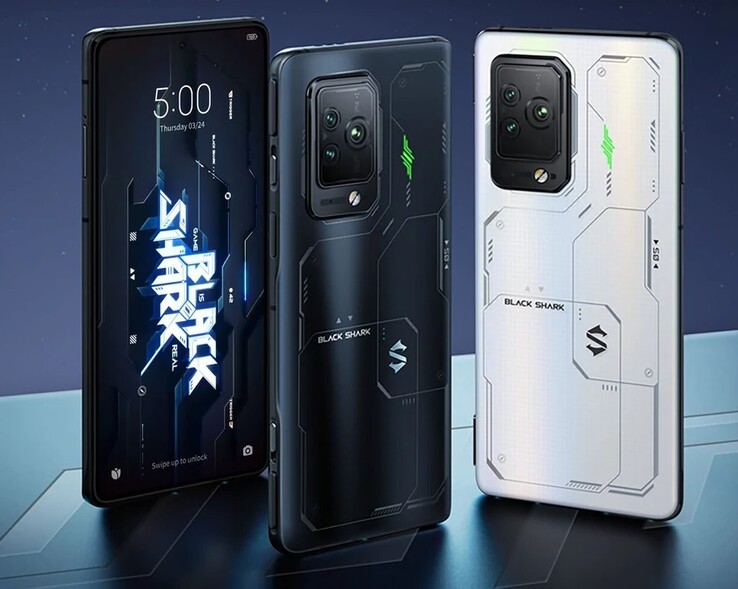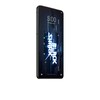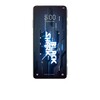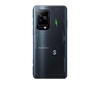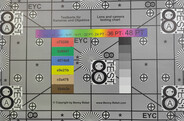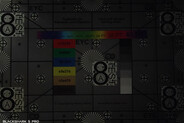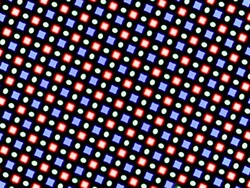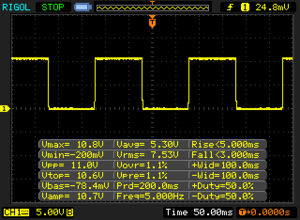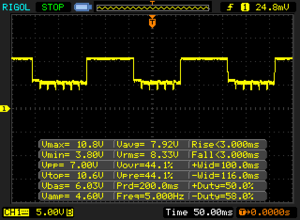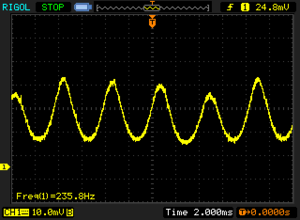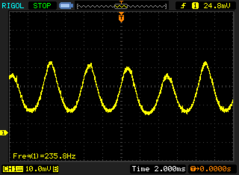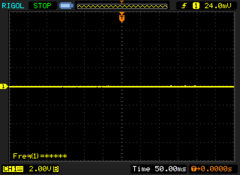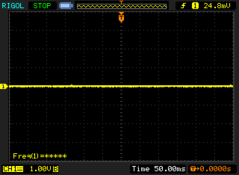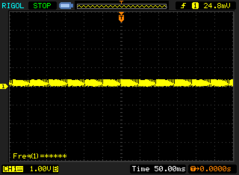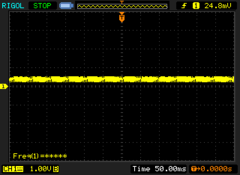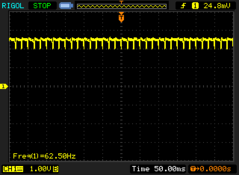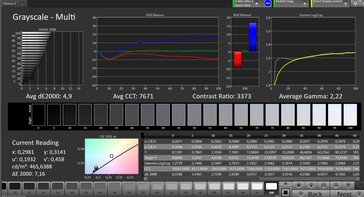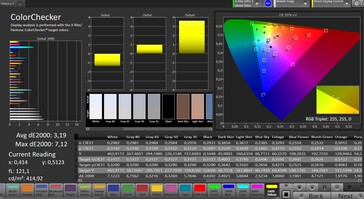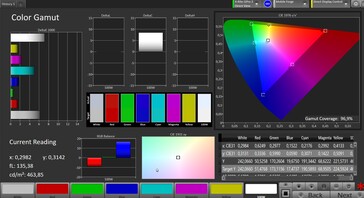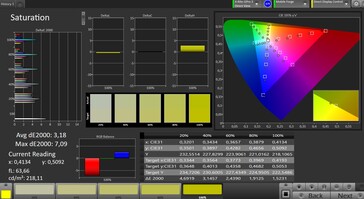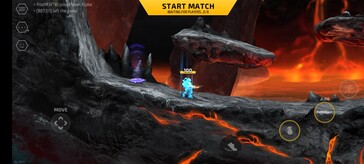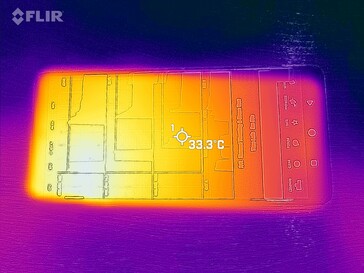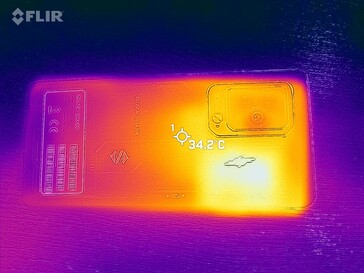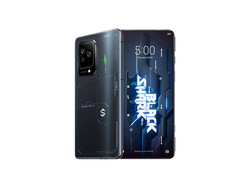Xiaomi Black Shark 5 Pro Smartphone Review - The best phone for gaming?
Possible competitors in comparison
Rating | Date | Model | Weight | Drive | Size | Resolution | Price |
|---|---|---|---|---|---|---|---|
| 85.7 % v7 (old) | 06 / 2022 | Xiaomi Black Shark 5 Pro SD 8 Gen 1, Adreno 730 | 220 g | 256 GB UFS 3.1 Flash | 6.67" | 2400x1080 | |
| 86.3 % v7 (old) | 07 / 2021 | Xiaomi Black Shark 4 SD 870, Adreno 650 | 210 g | 128 GB UFS 3.1 Flash | 6.67" | 2400x1080 | |
| 88.7 % v7 (old) | 12 / 2021 | Asus ROG Phone 5s SD 888+ 5G, Adreno 660 | 238 g | 512 GB UFS 3.1 Flash | 6.78" | 2448x1080 | |
| 85 % v7 (old) | 03 / 2022 | Nubia RedMagic 7 SD 8 Gen 1, Adreno 730 | 226 g | 256 GB UFS 3.1 Flash | 6.80" | 2400x1080 |
Case and equipment: Could be of higher quality
Xiaomi was a pioneer in gaming phones when it launched its first Black Shark-branded phone a few years ago. The 5th generation of the Pro model once again has a lot of what you would expect from a gaming phone on paper and, at €799 (~US$799), it is already much cheaper than the competition such as the Asus ROG Phone 5s.
Specifically, the Black Shark 5 Pro is available in the following variants:
- Xiaomi Black Shark 5 Pro 8 GB RAM / 128 GB mass storage: €799
- Xiaomi Black Shark 5 Pro 12 GB RAM / 256 GB mass storage: €899
- Xiaomi Black Shark 5 Pro 16 GB RAM / 256 GB mass storage: €999
Unfortunately, the most expensive variant was hardly available at the time of testing, and a pure RAM upgrade alone for €100 is unlikely to be worthwhile for most users.
White and black color options are available, but the Pro model traditionally has a bolder design than the Black Shark 5 that features a matte coating on the back with lines that resemble circuit diagrams or futuristic markings on machines. The smartphone feels good in the hand, but only looks average overall and can be easily dented in the center of the back.
There is still no IP certification and the USB-C port is only connected according to the USB 2.0 standard internally, which results in slow data transfers. However, NFC and Bluetooth 5.2 are onboard.
Communication, software, and operation: No timely security updates
The Black Shark 5 Pro features Wi-Fi 6 and is even a bit faster than its predecessor. 5G is also included along with support for so many 4G frequencies that you can easily access mobile Internet when traveling to most places.
The Black Shark 5 Pro uses JoyUI 13, which is based on Android 12. The security updates are from March 2022 at the time of testing and thus urgently need an update. "Every few months for two years" is the manufacturer's update philosophy when asked.
Two magnetic triggers on the long side, which can be folded out mechanically, are included. Of course, they are primarily intended as shoulder buttons and can be assigned functions in many games. They can also be used as additional buttons during everyday smartphone use. Xiaomi has come up with a few functions, but not all of them are described in a way that you would understand when you first read them. The only recourse is to try and figure them out yourself.
The fingerprint sensor is located on the casing's right in the standby button. It unlocks the device with minimal delay and reliably detects our finger. Unlocking via face recognition is also possible, but only in 2D. This is obviously more insecure and should not be used for security unlocking, for example in banking apps.
| Networking | |
| iperf3 transmit AX12 | |
| Asus ROG Phone 5s | |
| Xiaomi Black Shark 4 | |
| iperf3 receive AX12 | |
| Asus ROG Phone 5s | |
| Xiaomi Black Shark 4 | |
| iperf3 transmit AXE11000 | |
| Nubia RedMagic 7 | |
| iperf3 receive AXE11000 | |
| Nubia RedMagic 7 | |
| iperf3 transmit AXE11000 6GHz | |
| Xiaomi Black Shark 5 Pro | |
| iperf3 receive AXE11000 6GHz | |
| Xiaomi Black Shark 5 Pro | |
Cameras: Black Shark 5 Pro offers good image quality
Thanks to the new 108 MP main camera in the Black Shark 5 Pro, photos are recorded with a resolution of 27 MP by default. This is because the camera uses pixel binning for a higher light yield, but it can also use the full resolution if desired.
The photos look a bit blurred, but we actually like the brightening quite a bit. Pictures turn out well with good details and sharpness, especially in low light and high contrasts. As in the predecessor, a wide-angle lens and a macro lens are also available. These do a decent job, but the pictures are hardly usable outside of the phone's display due to the relatively low level of detail. The software does not allow multi-stage zooming between the wide-angle and main lens, but only direct switching.
Videos can be recorded at a maximum of 4K resolution and at 60 fps with the main camera. The brightness adjustment and autofocus react very quickly and appropriately for the light situation, so it is possible to create good video recordings.
The front-facing 20 MP camera takes decent selfies that can be enlarged a bit without too much quality loss.
Image comparison
Choose a scene and navigate within the first image. One click changes the position on touchscreens. One click on the zoomed-in image opens the original in a new window. The first image shows the scaled photograph of the test device.
Hauptkamera BlumeHauptkamera UmgebungHauptkamera Low Light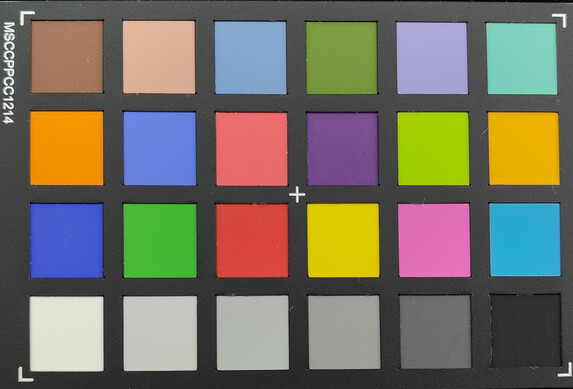
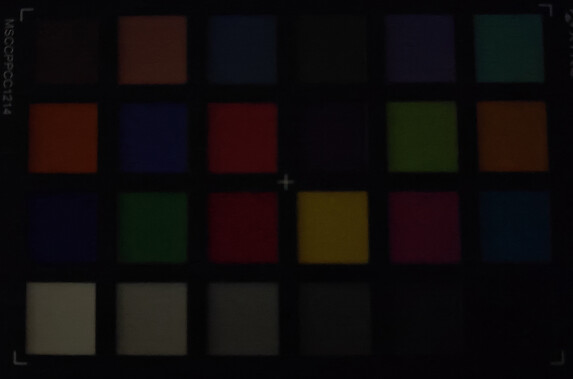
Display: AMOLED with 144 Hz
The display seems to be the same panel as in the predecessor Black Shark 4. The measured values deviate slightly here and there, but that might be due to the new SoC and the modified software.
Furthermore, the AMOLED screen has an expanded Full HD resolution and can get relatively bright when desired. However, we cannot measure the 1,300 nits that Xiaomi specifies as the maximum brightness with our spectrophotometer, even with a small illuminated display area.
| |||||||||||||||||||||||||
Brightness Distribution: 96 %
Center on Battery: 642 cd/m²
Contrast: ∞:1 (Black: 0 cd/m²)
ΔE ColorChecker Calman: 3.19 | ∀{0.5-29.43 Ø4.78}
ΔE Greyscale Calman: 4.9 | ∀{0.09-98 Ø5}
96.9% sRGB (Calman 2D)
Gamma: 2.22
CCT: 7671 K
| Xiaomi Black Shark 5 Pro AMOLED, 2400x1080, 6.7" | Xiaomi Black Shark 4 Super AMOLED, 2400x1080, 6.7" | Asus ROG Phone 5s AMOLED, 2448x1080, 6.8" | Nubia RedMagic 7 AMOLED, 2400x1080, 6.8" | |
|---|---|---|---|---|
| Response Times | -29% | 65% | 86% | |
| Response Time Grey 50% / Grey 80% * (ms) | 6 ? | 11 ? -83% | 2.4 ? 60% | 0.912 ? 85% |
| Response Time Black / White * (ms) | 8 ? | 6 ? 25% | 2.4 ? 70% | 1.038 ? 87% |
| PWM Frequency (Hz) | 235 | 162.3 | 575 ? | 729 |
| Screen | -14% | 36% | 1% | |
| Brightness middle (cd/m²) | 642 | 676 5% | 749 17% | 683 6% |
| Brightness (cd/m²) | 637 | 669 5% | 750 18% | 685 8% |
| Brightness Distribution (%) | 96 | 98 2% | 97 1% | 95 -1% |
| Black Level * (cd/m²) | ||||
| Colorchecker dE 2000 * | 3.19 | 5.77 -81% | 1.4 56% | 3.6 -13% |
| Colorchecker dE 2000 max. * | 7.12 | 9.81 -38% | 2.8 61% | 6.7 6% |
| Greyscale dE 2000 * | 4.9 | 3.7 24% | 1.8 63% | 5 -2% |
| Gamma | 2.22 99% | 1.959 112% | 2.29 96% | 2.14 103% |
| CCT | 7671 85% | 6584 99% | 6602 98% | 7537 86% |
| Total Average (Program / Settings) | -22% /
-18% | 51% /
43% | 44% /
22% |
* ... smaller is better
Display Response Times
| ↔ Response Time Black to White | ||
|---|---|---|
| 8 ms ... rise ↗ and fall ↘ combined | ↗ 5 ms rise | |
| ↘ 3 ms fall | ||
| The screen shows fast response rates in our tests and should be suited for gaming. In comparison, all tested devices range from 0.1 (minimum) to 240 (maximum) ms. » 21 % of all devices are better. This means that the measured response time is better than the average of all tested devices (20.2 ms). | ||
| ↔ Response Time 50% Grey to 80% Grey | ||
| 6 ms ... rise ↗ and fall ↘ combined | ↗ 3 ms rise | |
| ↘ 3 ms fall | ||
| The screen shows very fast response rates in our tests and should be very well suited for fast-paced gaming. In comparison, all tested devices range from 0.165 (minimum) to 636 (maximum) ms. » 17 % of all devices are better. This means that the measured response time is better than the average of all tested devices (31.6 ms). | ||
Screen Flickering / PWM (Pulse-Width Modulation)
| Screen flickering / PWM detected | 235 Hz | ||
The display backlight flickers at 235 Hz (worst case, e.g., utilizing PWM) . The frequency of 235 Hz is relatively low, so sensitive users will likely notice flickering and experience eyestrain at the stated brightness setting and below. In comparison: 53 % of all tested devices do not use PWM to dim the display. If PWM was detected, an average of 8111 (minimum: 5 - maximum: 343500) Hz was measured. | |||
PWM measurement series with fixed zoom level and different brightness settings
Performance, emissions, and battery life: Heating issues abound
The manufacturer relies on the modern Snapdragon 8 Gen. 1 SoC as the high-end chipset of choice. In fact, the Black Shark 5 Pro is superior to its predecessor by 10-20% in terms of performance in our benchmarks. Availability of fast memory also ensures a smooth system.
However, the Black Shark 5 Pro cannot always surpass its rivals with older chipsets in terms of graphics performance. This might be due to the fact that the SoC heats up a lot and thus probably has to throttle quickly in order not to overheat.
This probably explains why more than 60 fps was not attainable in the games we tested, even when the "Ludicrous" performance mode is enabled in "Shark Space". By the way, Black Shark recommends a separately available cooler for this performance mode, which is placed centrally on the device.
The stereo speakers on the phone's edges can get very loud if desired and spread a good mood when gaming or listening to music. This is ensured by the decent low mids — only really bass-emphasized parts sound a bit flat. There is no 3.5 mm audio jack, but USB-C or Bluetooth can be used to connect headphones. The smartphone also communicates wirelessly via all currently available aptX codecs.
The battery has is a bit more enduring this time with 4,650 mAh capacity and charges at a very fast 120 W. In contrast to the Black Shark 4, a suitable 120 W charger is included this time, which reduces the charging time to just under 30 minutes. The smartphone also lasts a bit longer than its predecessor. It is obvious that the Black Shark 5 Pro is designed for performance rather than battery life, but 12:32 hours in our Wi-Fi test is still a good endurance.
| GFXBench | |
| on screen Aztec Ruins Normal Tier Onscreen (sort by value) | |
| Xiaomi Black Shark 5 Pro | |
| Xiaomi Black Shark 4 | |
| Asus ROG Phone 5s | |
| Nubia RedMagic 7 | |
| Average Qualcomm Snapdragon 8 Gen 1 (38 - 98, n=20) | |
| Average of class Smartphone (6.2 - 166, n=211, last 2 years) | |
| 1920x1080 Aztec Ruins Normal Tier Offscreen (sort by value) | |
| Xiaomi Black Shark 5 Pro | |
| Xiaomi Black Shark 4 | |
| Asus ROG Phone 5s | |
| Nubia RedMagic 7 | |
| Average Qualcomm Snapdragon 8 Gen 1 (60 - 131, n=22) | |
| Average of class Smartphone (3.4 - 367, n=211, last 2 years) | |
| on screen Aztec Ruins High Tier Onscreen (sort by value) | |
| Xiaomi Black Shark 5 Pro | |
| Xiaomi Black Shark 4 | |
| Asus ROG Phone 5s | |
| Nubia RedMagic 7 | |
| Average Qualcomm Snapdragon 8 Gen 1 (27 - 69, n=20) | |
| Average of class Smartphone (0.85 - 144, n=212, last 2 years) | |
| 2560x1440 Aztec Ruins High Tier Offscreen (sort by value) | |
| Xiaomi Black Shark 5 Pro | |
| Xiaomi Black Shark 4 | |
| Asus ROG Phone 5s | |
| Nubia RedMagic 7 | |
| Average Qualcomm Snapdragon 8 Gen 1 (19 - 49, n=22) | |
| Average of class Smartphone (1.2 - 129, n=211, last 2 years) | |
| Xiaomi Black Shark 5 Pro | Xiaomi Black Shark 4 | Asus ROG Phone 5s | Nubia RedMagic 7 | Average 256 GB UFS 3.1 Flash | Average of class Smartphone | |
|---|---|---|---|---|---|---|
| AndroBench 3-5 | -30% | -23% | -17% | -18% | 1% | |
| Sequential Read 256KB (MB/s) | 1945.4 | 1663 -15% | 1972 1% | 1750 -10% | 1757 ? -10% | 2216 ? 14% |
| Sequential Write 256KB (MB/s) | 1485.2 | 760 -49% | 770 -48% | 1260 -15% | 1204 ? -19% | 1837 ? 24% |
| Random Read 4KB (MB/s) | 344.9 | 283.1 -18% | 297.8 -14% | 306.2 -11% | 287 ? -17% | 294 ? -15% |
| Random Write 4KB (MB/s) | 424.8 | 259.9 -39% | 287.2 -32% | 282.5 -33% | 318 ? -25% | 334 ? -21% |
Gaming Benchmarks
| Armajet - Deathmatch, 4vs4, Magma, Bots only | |
| Xiaomi Black Shark 5 Pro | |
| Samsung Galaxy S22 | |
Temperature
(-) The maximum temperature on the upper side is 46 °C / 115 F, compared to the average of 35.2 °C / 95 F, ranging from 21.9 to 247 °C for the class Smartphone.
(-) The bottom heats up to a maximum of 48.1 °C / 119 F, compared to the average of 34 °C / 93 F
(+) In idle usage, the average temperature for the upper side is 25.3 °C / 78 F, compared to the device average of 32.9 °C / 91 F.
Loudspeaker
Xiaomi Black Shark 5 Pro audio analysis
(+) | speakers can play relatively loud (86.2 dB)
Bass 100 - 315 Hz
(-) | nearly no bass - on average 20% lower than median
(±) | linearity of bass is average (8.4% delta to prev. frequency)
Mids 400 - 2000 Hz
(±) | higher mids - on average 5.6% higher than median
(+) | mids are linear (4.6% delta to prev. frequency)
Highs 2 - 16 kHz
(+) | balanced highs - only 3.1% away from median
(+) | highs are linear (2.8% delta to prev. frequency)
Overall 100 - 16.000 Hz
(±) | linearity of overall sound is average (16.3% difference to median)
Compared to same class
» 6% of all tested devices in this class were better, 5% similar, 89% worse
» The best had a delta of 11%, average was 35%, worst was 134%
Compared to all devices tested
» 26% of all tested devices were better, 6% similar, 69% worse
» The best had a delta of 4%, average was 24%, worst was 134%
Nubia RedMagic 7 audio analysis
(+) | speakers can play relatively loud (91.8 dB)
Bass 100 - 315 Hz
(-) | nearly no bass - on average 21.9% lower than median
(+) | bass is linear (6.9% delta to prev. frequency)
Mids 400 - 2000 Hz
(±) | higher mids - on average 5.8% higher than median
(+) | mids are linear (4.5% delta to prev. frequency)
Highs 2 - 16 kHz
(±) | higher highs - on average 6.9% higher than median
(+) | highs are linear (4.8% delta to prev. frequency)
Overall 100 - 16.000 Hz
(±) | linearity of overall sound is average (18.9% difference to median)
Compared to same class
» 23% of all tested devices in this class were better, 10% similar, 68% worse
» The best had a delta of 11%, average was 35%, worst was 134%
Compared to all devices tested
» 43% of all tested devices were better, 8% similar, 49% worse
» The best had a delta of 4%, average was 24%, worst was 134%
Battery life
| Xiaomi Black Shark 5 Pro 4650 mAh | Xiaomi Black Shark 4 4500 mAh | Asus ROG Phone 5s 6000 mAh | Nubia RedMagic 7 4500 mAh | Average of class Smartphone | |
|---|---|---|---|---|---|
| Battery Runtime | |||||
| WiFi Websurfing (h) | 12.5 | 11.8 -6% | 12.2 -2% | 11.1 -11% | 19.3 ? 54% |
Pros
Cons
Verdict: Great gaming features but rarely more than 60 fps
Compared with the predecessor generation, the Black Shark 5 Pro looks to be a hesitant upgrade with a new outfit, upgraded processor, and a slightly higher-resolution camera. In everyday use, we are happy about the fast storage, the reliable fingerprint sensor, the good stereo speakers, and fast Wi-Fi. The in-house gaming mode "Shark Space" offers a huge variety of settings for every game.
What we are less enthusiastic about is the tendency for strong heating under load, which also leads to performance losses. The optional fan can be used to counteract this a bit. In many areas, the Xiaomi Black Shark 5 Pro is a pretty average upper-range smartphone. The casing stability could be better, especially for such an expensive phone. An IP certification would also be good to have.
The Black Shark 5 Pro is a fast gaming phone, but it cannot always show its strengths.
Not only gamers but regular users too will be interested in the triggers, which can also be mapped for everyday navigation through the system. In terms of software, however, the manufacturer needs to clarify how some points are to be understood — a more regular update cadence would be nice for such an expensive phone. Furthermore, in-game support for the 144 Hz display is still quite rare.
Features like wireless charging are missing in the competitor Asus ROG Phone 5s, but that phone has very powerful speakers and offers a lot of performance. The Nubia RedMagic 7 also offers additional keys but as touch buttons.
Price and availability
The Xiaomi Black Shark 5 Pro is available directly from the manufacturer starting at €799. The Black Shark 5 Pro is also available on amazon.de as well. The devices are available at the same prices with Amazon shipping.
Xiaomi Black Shark 5 Pro
- 08/30/2022 v7 (old)
Florian Schmitt




